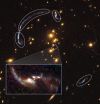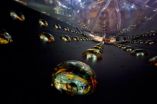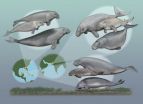(Press-News.org) The humble aspirin may soon have a new role. Scientists from The City College of New York have developed a new aspirin compound that has great promise to be, not only an extremely potent cancer-fighter, but even safer than the classic medicine cabinet staple.
The new designer aspirin curbed the growth of 11 different types of human cancer cells in culture without harming normal cells, reported a team from the Sophie Davis School of Biomedical Education of The City College of New York in a paper published this month in the journal ACS Medicinal Chemistry Letters. The cancers controlled included colon, pancreatic, lung, prostate, breast, and leukemia. "The key components of this new compound are that it is very, very potent and yet it has minimal toxicity to the cells," said Associate Professor Khosrow Kashfi, the principal investigator.
The aspirin compound also shrank human colon cancer tumors by 85 percent in live animals, again without adverse effects, according to a second paper in press by the City College researchers and colleague Kenneth Olson of Indiana University School of Medicine, South Bend. Their results will appear in the journal Biochemical and Biophysical Research Communications, now available online. "If what we have seen in animals can be translated to humans," said Professor Kashfi, "it could be used in conjunction with other drugs to shrink tumors before chemotherapy or surgery."
Long the go-to drug for minor aches and pains, aspirin and other so-called non-steroidal anti-inflammatory drugs (NSAIDs) such as ibuprofen and naproxen, are known primarily for their ability to calm inflammation. Studies in the 1980's resolved a decades-old debate on the utility of a daily dose of aspirin to cut the risk of heart attack and stroke.
More recent studies tracking regular use of the drug and other NSAIDs demonstrated their remarkable ability to inhibit the growth of cancer. "There's a lot of data on aspirin showing that when taken on a regular basis, on average it reduces the risk of development of colon cancer by about 50% compared to nonusers," noted Professor Kashfi.
The fly in the ointment has been that prolonged use of aspirin posed its own dangers: side effects ranging from bleeding ulcers to kidney failure. To resolve this, the researchers created a hybrid of two earlier formulations, which they have called "NOSH-aspirin." They used the aspirin as a scaffold to support two molecules that have been shown to increase the drug's safety and potency.
One arm of the hybrid aspirin releases nitric oxide (NO), which helps protect the stomach lining. The other releases hydrogen sulfide (H2S), which the researchers have previously shown enhances aspirin's cancer-fighting ability. The researchers suspected that the hybrid would be more effective than either of the two components alone to boost aspirin's safety and power against cancer.
"The hybrid is more potent – and it is more potent by orders of magnitude – compared to aspirin," said Kashfi. Only 24 hours after treating a culture of cancer cells, the NOSH-aspirin demonstrated 100,000 times greater potency than aspirin alone. "At 72 hours it is about 250,000 times more potent in an in-vitro cell culture against human colon cancer," Kashfi added. "So you need a lower amount to get the same result."
The effect of the hybrid was also far greater than the sum of its parts. Its potency was as much as 15,000 times greater than existing NO-aspirins and 80-fold more than those that incorporate H2S. The upshot is that a drug based on this hybrid would require lower doses to be effective, minimizing or potentially eliminating its side effects.
In the second study, when mice bearing human colon cancer tumors on their flanks were given oral NOSH-aspirin, the compound caused cancer cells to self-destruct, inhibited the proliferation of the cells and significantly reduced tumor growth without any signs of toxicity in the mice.
The stage is set for the development of a drug based on NOSH-aspirin. Kashfi noted that any working therapy for humans is years away, but the next step would be toxicity testing, and then clinical trials.
Dr. Ravinder Kodela and Dr. Mitali Chattopadhyay are members of Professor Kashfi's lab at Sophie Davis School of Biomedical Education and co-authors on both papers. These studies were funded by The National Cancer Institute through a subcontract from ThermoFisher, and also by the National Science Foundation.
Professor Kashfi and his colleagues will present these findings at the annual meeting of the American Association for Cancer Research in Chicago, March 31st - April 4th.
INFORMATION:
On the Internet:
Khoshrow Kashfi profile:
http://www1.ccny.cuny.edu/prospective/med/faculty/kkashfi.cfm
References:
Ravinder Kodela, Mitali Chattopadhyay, and Khosrow Kashfi. NOSH-Aspirin: A Novel Nitric Oxide–Hydrogen Sulfide-Releasing Hybrid: A New Class of Anti-inflammatory Pharmaceuticals. Published online ACS Medicinal Chemistry Letters Article ASAP Publication Date (Published online ahead of print January 28, 2012) doi: 10.1021/ml300002m
http://pubs.acs.org/doi/abs/10.1021/ml300002m
M. Chattopadhyay et al., NOSH–aspirin (NBS-1120), a novel nitric oxide- and hydrogen sulfide-releasing hybrid is a potent inhibitor of colon cancer cell growth in vitro and in a xenograft mouse model, Biochem. Biophys. Res. Commun. (In press. Available online February 2012), doi:10.1016/j.bbrc.2012.02.051
http://www.sciencedirect.com/science/article/pii/S0006291X12002847
END
NEW YORK – Attracting workers into science and technology fields could be hampered by work-life integration issues according to a new international survey. Drawing data from 4,225 publishing scientists and researchers worldwide, the Association for Women in Science (AWIS) finds that lack of flexibility in the workplace, dissatisfaction with career development opportunities and low salaries are driving both men and women to re-consider their profession.
More than half (54%) of all scientists and researchers said that work demands conflict with their personal lives at ...
PASADENA, Calif.—In both animals and humans, vocal signals used for communication contain a wide array of different sounds that are determined by the vibrational frequencies of vocal cords. For example, the pitch of someone's voice, and how it changes as they are speaking, depends on a complex series of varying frequencies. Knowing how the brain sorts out these different frequencies—which are called frequency-modulated (FM) sweeps—is believed to be essential to understanding many hearing-related behaviors, like speech. Now, a pair of biologists at the California Institute ...
Dr Jill, formerly a health care professional, joined ProU this fall to learn skills and to grow her online business, working from home. Things are going well and she has moved up within ProU. In February 2012, Dr Jill has advanced twice. Dr Jill upgraded to Master Affiliate and is now eligible and looking forward to attending and learning even more at the next ProU Master Marketing Event. Dr Jill also upgraded to Ascent Level of ProU program. At this new, higher level she is eligible to attend the BREAKTHROUGH Mastery Workshop and have access to the recorded 12 month BREAKTHROUGH ...
Thanks to the presence of a natural "zoom lens" in space, University of Chicago scientists working with NASA's Hubble Space Telescope have obtained a uniquely close-up look at the brightest gravitationally magnified galaxy yet discovered.
The imagery offers a visually striking example of gravitational lensing, in which one massive object's gravitational field can magnify and distort the light coming from another object behind it.
Such optical tricks stem from Einstein's theory of general relativity, which describes how gravity can warp space and time, including bending ...
Minority principals and other administrative personnel at elementary and high schools play a key role in implementing policies and practices aimed at engaging immigrant parents of students, according to new research from Rice University, the University of Wisconsin–Milwaukee and Vanderbilt University.
The researchers examined how schools in districts with immigrant populations are addressing low levels of parent involvement in their children's education and providing opportunities for engagement and support. The study, which will be published in the March edition of ...
PASADENA, Calif.—An international team of physicists—including several from the California Institute of Technology (Caltech)—has detected and measured, for the first time, a transformation of one particular type of neutrino into another type. The finding, physicists say, may help solve some of the biggest mysteries about the universe, such as why the universe contains more matter than antimatter—a phenomenon that explains why stars, planets, and people exist at all.
The results, released online on March 8, come from the Daya Bay Reactor Neutrino Experiment, which consists ...
Fantazzle Fantasy Sports Games is awarding its community with two different Free March Madness Bracket Games that will be offering several hundred dollars in prizes. The first contest, available for entry now, will be offering $250 in prizes and is the traditional tournament-long bracket. The second bracket will be available for entry shortly after the first bracket game starts and will include the final 32 teams.
"We ran a free bracket game last year that was sponsored by Steiner Sports and it was such a success that we decided to run another game this year. Then, ...
The long-term impact of climate change on natural communities of wild animals could be better understood thanks to a new study.
The research will help predict how migration of animals or changes to their habitats associated with climate change could impact on the evolution of relationships between predators and their prey.
Scientists have shed light on how species and their natural enemies chase each other across continents in a game of cat and mouse lasting for millions of years. They used a technique known as population genetics to reveal historical information hidden ...
Scientists have made fresh discoveries about the processes that govern plants' internal body clocks and help them adjust to changing seasons, triggering the arrival of flowers in spring.
Researchers tested computer models of gene networks in a simple cress plant to determine the role played by a protein, known as TOC1, in governing these daily cycles. The model shows how 12 genes work together to run the plant's complex clockwork, and reset the clock at dawn and dusk each day.
Researchers found that the TOC1 protein, which was previously associated with helping plants ...
Sirenians, or seacows, are a group of marine mammals that include manatees and dugongs; today, only one species of seacow is found in each world region. Smithsonian scientists have discovered that this was not always the case. According to the fossil record of these marine mammals, which dates back 50 million years ago, it was more common to find three, or possibly more, different species of seacows living together at one time. This suggests that the environment and food sources for ancient seacows were also different than today. The team's findings are published in the ...





